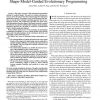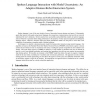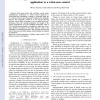92 search results - page 14 / 19 » Adapting simulated behaviors for new characters |
TMI
2002
13 years 7 months ago
2002
This paper presents a fully automated segmentation method for medical images. The goal is to localize and parameterize a variety of types of structure in these images for subsequen...
CONNECTION
2008
13 years 7 months ago
2008
Spoken language is one of the most intuitive forms of interaction between humans and agents. Unfortunately, agents that interact with people using natural language often experienc...
ALIFE
2000
13 years 7 months ago
2000
The evolution of simulated robots with three different architectures is studied in this article. We compare a nonmodular feed-forward network, a hardwired modular, and a duplicatio...
CDC
2008
IEEE
14 years 2 months ago
2008
IEEE
— This paper deals with real-time control under computational constraints. A robust control approach to control/real-time scheduling co-design is proposed using the H∞ framewor...
GLOBECOM
2007
IEEE
14 years 1 months ago
2007
IEEE
— In this paper, we discuss our preliminary work on signaling overload control for cellular services which requires adaptability and scalability as well as guaranteed level of se...




